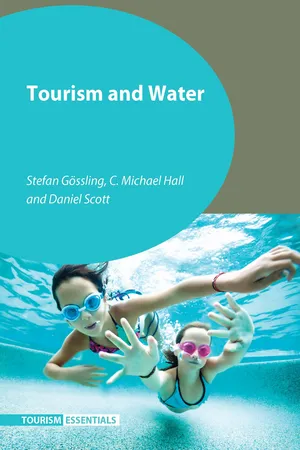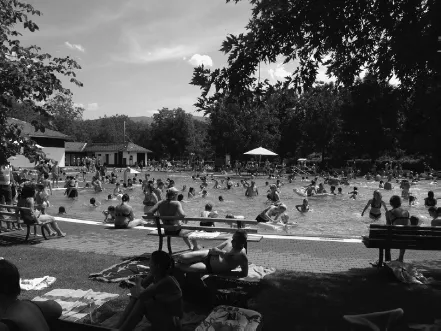![]()
1 Water for Life: A Global Overview
Water has many meanings for human beings. First and foremost, we need water for life. The World Health Organization (WHO, 2011) suggests that a minimum of 7.5–15 L per person per day are necessary for survival, with 2.5–3.0 L for drinking and food, 2–6 L for basic hygiene practices, and 3–6 L for basic cooking needs. This estimate of required water is for basic human needs, and not a reflection of water ‘wants’ for a much wider range of other purposes (Lundqvist & Gleick, 1997). Importantly, it is also only a measure of direct water use and water actually contained in food and beverages consumed (for proper hydration and bodily functions), but does not reflect the much greater water footprint of food produced elsewhere or the energy required to provide this amount of freshwater.
Throughout human history, water access and increasingly sophisticated water management practices have been a hallmark of civilisation and often one of its greatest challenges. Sedlak (2014) describes how around 700 bce the residents of Erbil in modern northern Iraq dug tunnels to channel groundwater into the city over distances of 20 km. Similar techniques of water collection and storage were developed by cities in Greece at around the same time and independently by cultures from Chile to China. The Romans built the first water systems that would not only supply water but also provide drainage and waste water management and, by 300 bce, when local groundwater sources were exhausted, Rome’s water system was expanded to include aqueducts and pipeline systems. Such systems were built throughout the Roman world with, in some cases, their water engineering legacies lasting to the present day. As noted by Schwarz et al. (1990), the uses of water have continued to diversify in modern industrial and knowledge-based economies:
Over the past three centuries, the major transforming activities of humankind – population growth and urbanization, agricultural development and the expansion of arable land, industrial development and the rise of the modern world economy, and the production and consumption of energy (i.e., fossil fuels and hydroelectricity) – have directly and indirectly affected water quality and availability, which, in turn, have had a profound effect on human health. (Schwarz et al., 1990: 254)
With its critical life-sustaining properties, it should therefore be no surprise that water has tremendous symbolic meaning in many cultures. Water is intrinsic to spiritual beliefs worldwide, with many early cultures having water deities and mythical water creatures and spirits as part of their folklore. For Christians, and other Abrahamic religions, partial or full immersion in water is a rite of purification (Collins, 1995). The Qur’an refers to the origin of life in water:
Have those who disbelieved not considered that the heavens and the earth were a joined entity, and We separated them and made from water every living thing
Then will they not believe
(Qur’an, 2014: verse 21:30)
This reminds us of human evolution from its origins in single cell structures involving carbon and water (e.g. Alberts et al., 2007). Similarly, the holy books of the Hindus (the Vedas) explain that the inhabitants of the earth emerged from the primordial sea.
Over centuries, the sea has remained a place of mystery and exploration. The Oceanic peoples of the Pacific (Melanesian, Polynesian and Micronesian) are highly mobile voyaging peoples for whom connecting and colonising new territories have been the norm for thousands of years. The Pacific Ocean necessitated ocean-going canoe technology in order to be able to voyage across it. This was developed within the last 10,000 years (Howe, 2007), although Australia and New Guinea were settled by modern humans 50,000 years ago. In terms of human migration, the Pacific Islands were the most difficult to reach and so are some of the most recently settled parts of the world. Nevertheless, this is an important historical and cultural context as, in contrast to Westerners who view the Pacific as a vast ocean, sprinkled with a few islands, Pacific peoples see the region as a readily accessed ‘sea of islands’ (Hau’ofa, 1997).
In the modern era, Thor Heyerdahl (1979) demonstrated that the oceans would not divide but connect the continents, representing routes of settlement and trade in new areas. The art of navigation at sea was developed by the Phoenicians approximately 4000 years ago (2000 bce). In the Mediterranean Sea and the western Indian Ocean, trade systems have existed for more than 2500 years. European seafarers with superior ship construction began to explore and exploit the world’s oceans from the 15th century onwards.
Cartographers of this time have depicted seas as full of wild and dangerous creatures. Later on, however, the sea also became part of the Romantic image of humanity in balance with nature, referring to a paradise on Earth (Jean- Jacques Rousseau), and closely related to the discovery of the South Seas by James Cook (first Pacific voyage 1768–1771; Fagan, 1998). What reached Europe were narratives of peace, hospitality, abundant food and free love:
The Tahitians in all their innocent simplicity seemed to have achieved a happiness in this world that had escaped European civilizations for centuries. Many preferred to believe that the search for paradise on Earth was over; indeed, the myth of the paradisal South Seas persists to this day. (Fagan, 1998: 146)
While blue water, sandy beaches and sunshine remain the foundation for the most important form of contemporary tourism (Bramwell, 2004), our perception of the oceans remains one of mystery, in large part due to the fact that most humans will never enter oceans below a depth of 20 m, equivalent to a scuba open water diver. As a result, our understandings of the ocean are dominated by documentaries, movies and animations, from Cousteau’s Silent World (1956) to Steven Spielberg’s Jaws (1974) and Disney’s Finding Nemo (2003), itself part of a campaign to attract international tourists to Queensland (Beeton, 2005). The deep sea remains the last frontier in exploration, recently inspiring film director James Cameron to turn his own journey into the Mariana Trench (10,908 m) into a movie (Deepsea Challenge). The mysteries of an alien environment containing colourful fishes and coral reef environments, and the prospect of clear, warm waters have piqued the interest of a growing number of divers and snorkelers in tropical destinations (Garrod & Gössling, 2007). For instance, the Professional Association of Diving Instructors (PADI), the world’s largest dive organisation, estimates that since 1967 some 22 million divers have been certified by PADI alone, growing in excess of 900,000 per year (PADI, 2014). Yet it is the coastal zones that remain, for most tourists, the link between land and sea, and beach environments continue to be the most popular destinations (Hall & Page, 2014). Southern and Mediterranean countries in Europe, for instance, received more than 200 million tourist arrivals in 2013, and the Caribbean more than 20 million (UNWTO, 2014).
Entirely different is our perception of inland water bodies or ‘lacustrine systems’ (Hall & Härkönen, 2006). Used for a wide range of recreational activities, lakes and streams also form important elements of urban, mountain and other landscapes visited by tourists. Specifically, boating and fishing have been identified as recreational activities of great economic relevance (Hall & Härkönen, 2006; Jones et al., 2006), although the scenic value of lakes for destinations continues to remain insufficiently understood. Rivers are equally important for tourism, supporting renowned scenic tours in destinations as diverse as the Nile River–Luxor (Egypt), the Yangtze–Three Gorges Dam (China), the Danube (Germany, Austria, Hungary) and the Mekong (Vietnam) and popular activities such as boating, kayaking or canoeing and fishing (Prideaux & Cooper, 2009). In many countries, public pools are visited by millions of visitors every day in the hot summer season (2hm & Associates, 2012; see Plate 1.1).
Many forms of tourism are also indirectly dependent on water availability and quality. The growing global golf tourism market is dependent in most destinations on significant turf grass irrigation. Similarly, an increasing number of skiing and winter sports tourism destinations utilise substantial volumes of water for snowmaking to ensure a quality snow product and to expand the tourism season. Agritourism depends on water for crop production, and wildlife tourism depends on water availability for the species observed. Both water availability and water quality changes can have negative consequences for tourism. Notable recent examples of the enormous ecological and financial cost associated with the restoration of ecosystems suffering from low water quality or falling water levels include the Everglades and Great Lakes in North America, both World Nature Heritage Sites (Shlozberg et al., 2014; UNESCO, 2009), as well as the Aral and Dead Seas.
Plate 1.1 A hot summer’s day in a public pool in Freiburg, Germany. In central Europe, where private pools are not as common as in North America, thousands of public pools attract hundreds of thousands of visitors each day in summer. In Germany alone, there are almost 7500 public pools, probably visited by several million visitors on a hot summer’s day
Where water quality is affected by contaminants (biological and/or chemical), or has unwanted thermal or other physical properties, the environment may be perceived by tourists as being of diminished quality. In some areas, poor water quality is already seen as the main barrier to developing tourism (Schernewski et al., 2001). Where water pollution involves nitrogen and phosphorous discharge, this can result in algal blooms, which have been increasing globally since the 1970s (Anderson, 2009) and have triggered highly visible media stories that can affect destination perception and reputation (Plate 1.2). For example, prior to hosting the Beijing Summer Olympics the beaches of the coastal resort of Qingdao in China were blanketed by bright green algae. Algae are a health risk, but also affect aesthetics because of ...



